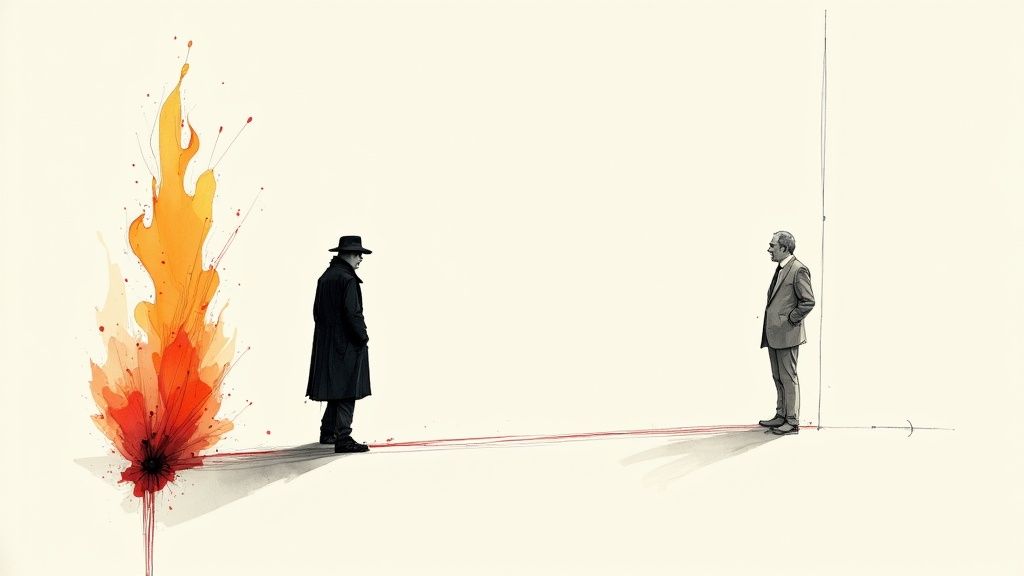Stepping into the world of Kurt Wallander is to enter the rain-swept streets of Ystad, Sweden, and the troubled mind of one of crime fiction's most iconic detectives. Created by Henning Mankell, the Wallander series is a masterclass in Scandinavian noir, blending gripping police procedurals with profound social commentary and a deep, melancholic character study.
But with over a dozen titles, including novels and novellas, knowing where to begin can be a challenge for new readers. This guide provides the definitive Kurt Wallander series order, ensuring you experience the detective's journey-from his first case to his final bow-exactly as intended. We will explore both the publication and chronological order, offering insights into each novel's unique place in the saga.
Whether you're discovering Mankell for the first time or revisiting a classic, use this as your roadmap to navigate Wallander's complex and compelling world without missing a single crucial development.
1. Faceless Killers (1991)
The essential starting point for any reader looking to understand the correct Kurt Wallander series order is Henning Mankell's gripping debut, Faceless Killers. This novel introduces Inspector Kurt Wallander of the Ystad police, a profoundly human and flawed detective. We meet him at a low point in his life, grappling with a recent divorce, a difficult relationship with his estranged daughter Linda, and concern for his aging father.
The case begins with the shockingly brutal and seemingly senseless murder of an elderly couple at their remote farmhouse. Before she dies, the wife utters a single, fateful word: “foreign.” This whisper ignites a firestorm of anti-immigrant sentiment in the small community, pressuring Wallander's investigation and forcing him to confront uncomfortable truths about his own prejudices and the simmering racial tensions in 1990s Sweden.

Why It's the Essential Starting Point
Faceless Killers masterfully establishes the melancholic tone and socially-conscious themes that define the entire series. Mankell uses the crime narrative not just to create a compelling mystery but also to dissect the anxieties of a changing Swedish society. Starting here is crucial to appreciating Wallander’s complete character development.
Actionable Reading Tips
Read in Publication Order: While some series can be read out of sequence, starting with Faceless Killers is non-negotiable for the Wallander novels. His personal and professional journey is a continuous arc that builds from this foundational story.
Focus on the Atmosphere: Pay close attention to Mankell's descriptions of the Skåne landscape and the bleak winter weather. These elements are characters in their own right, reflecting Wallander's internal turmoil.
Consider the Social Context: The novel’s exploration of xenophobia was groundbreaking for its time and remains incredibly relevant. Understanding this social commentary is key to grasping the depth of the series. To explore the full list of characters introduced in this foundational novel, you can learn more about the cast of Faceless Killers (1991).
2. The Dogs of Riga (1992)
Following the intense local investigation of the first novel, The Dogs of Riga immediately broadens the scope of the Kurt Wallander series order by plunging the detective into a complex international conspiracy. The story begins when a life raft washes ashore in Skåne, containing the bodies of two unidentified men dressed in fine suits. The investigation quickly takes Wallander out of his familiar Swedish setting and into the murky, post-Soviet landscape of Riga, Latvia.
Navigating a nation grappling with its fragile new independence, Wallander finds himself dangerously out of his depth. He is caught in a web of police corruption, political intrigue, and shadowy forces from the old regime. This novel is a crucial step in his development, forcing him to confront a world far larger and more treacherous than he ever imagined, challenging his abilities and his trust in authority.

Why It's a Pivotal Second Step
The Dogs of Riga is essential because it demonstrates that the series will not be confined to small-town Swedish crime. Henning Mankell uses this plot to explore the geopolitical shifts of the early 1990s, showcasing the instability and paranoia gripping Eastern Europe after the fall of the Iron Curtain. It expands Wallander’s personal world and establishes the series' ambition to tackle global issues through the lens of a single, world-weary detective.
Actionable Reading Tips
Note the Shift in Tone: Pay attention to the change in atmosphere from the bleak Swedish winter in the first book to the oppressive, paranoid environment of Riga. This shift is intentional and reflects Wallander's own feelings of alienation and danger.
Appreciate the Historical Context: A basic understanding of the Soviet Union's dissolution will greatly enrich your reading experience. The novel powerfully captures the uncertainty and hope of a nation caught between its past and future.
Track Wallander's Isolation: This is the first time we see Wallander truly alone and vulnerable in a foreign land. Observing how he copes with this isolation is key to understanding his resilient, if troubled, character. To further explore the author's background and influences for this book, you can discover more about Henning Mankell's life and work.
3. The White Lioness (1993)
The third installment in the Kurt Wallander series order, The White Lioness, significantly expands the scope of the series beyond the rain-swept streets of Skåne. Mankell ambitiously connects a local Swedish crime to a high-stakes international conspiracy, showcasing his commitment to using the crime genre to explore major global issues. The story begins with the seemingly straightforward disappearance of a local real estate agent, but Wallander's investigation soon uncovers a chilling link to a plot to assassinate Nelson Mandela in post-apartheid South Africa.
This novel is a pivotal moment for the series, weaving Wallander's grounded, melancholic police work into a narrative of international political intrigue. The plot is informed by Mankell's own extensive experience living and working in Africa, adding a layer of authenticity to the story's South African elements and reflecting the real historical threats against Mandela during this transitional period.

Why It's a Key Turning Point
The White Lioness demonstrates that the Wallander series is not just about crime in a small Swedish town; it's about how that small town is connected to a complex and often unjust world. It deepens the series' social commentary by tackling themes of colonialism, racism, and political violence on a global scale. This book is essential for understanding Mankell's broader worldview.
Actionable Reading Tips
Understand the Historical Context: To fully appreciate the novel's tension, it helps to have a basic understanding of South Africa's transition from apartheid in the early 1990s. This context makes the assassination plot feel incredibly urgent and real.
Notice the Thematic Contrasts: Pay attention to how Mankell contrasts the mundane anxieties of Swedish life with the life-or-death political struggle in South Africa. This juxtaposition is central to the book's message about global responsibility.
Explore Mankell's Background: Consider reading about Henning Mankell's work with the Teatro Avenida in Mozambique. This background provides insight into his deep connection to Africa, which enriches the novel's perspective. For more guidance on tackling complex narratives, check out these tips for reading book series in order.
4. The Man Who Smiled (1994)
The fourth book in the Kurt Wallander series order, The Man Who Smiled, marks a significant turning point for the detective. Following a traumatic event in the previous case, Wallander has quit the police force, teetering on the edge of a complete breakdown. He is living in self-imposed exile, contemplating leaving his life's work behind for good when an old friend, a lawyer named Sten Torstensson, begs for his help.
Torstensson is convinced his father's recent accidental death was murder, linked to a powerful and charismatic philanthropist. Wallander initially refuses, but when his friend is also found dead, he is consumed by guilt and a thirst for justice. He reluctantly rejoins the Ystad police, pulling himself from the depths of despair to confront a conspiracy of power, corruption, and murder hidden behind a veneer of corporate respectability.
Why It's a Pivotal Read
This novel is essential for understanding Wallander's profound connection to his job. It’s not just a career for him; it's a calling he cannot escape, no matter how much it costs him personally. The story solidifies his identity as a detective driven by an unshakeable moral compass, even when his own life is in shambles.
Actionable Reading Tips
Trace the Character Arc: This book is crucial for seeing Wallander's resilience. Witnessing his return from the brink is a powerful part of his overall journey and sets the stage for his future development.
Contrast Internal and External Worlds: Note the stark contrast between Wallander's internal chaos and the polished, controlled facade of the novel's antagonist. This dynamic highlights the series' exploration of hidden darkness.
Observe Social Commentary: Mankell uses the plot to scrutinize class, wealth, and the corrupting influence of power within Swedish society, a theme that deepens the narrative beyond a simple crime story. For answers to common questions about the series, you can explore our reading order FAQ.
5. Sidetracked (1995)
Widely considered a high point in the Kurt Wallander series order, Sidetracked opens with one of the most haunting scenes in crime fiction. During a Midsummer's Eve celebration, Wallander witnesses a teenage girl set herself on fire in a rapeseed field. The shocking event is just the beginning, as a series of brutal scalping murders targeting prominent men follows, with the country's former minister of justice among the victims.
Wallander is forced to connect these seemingly disparate and grotesque events, delving into a dark world of exploitation and revenge. His professional struggles are mirrored by a deepening personal crisis, as he must confront the rapid decline of his father's health, pulling him between the demands of a horrifying case and his filial duties. This novel masterfully intertwines the procedural with the profoundly personal, creating an emotionally resonant and unforgettable narrative.

Why It's a Pivotal Entry
Sidetracked is often hailed as the quintessential Wallander novel and a masterpiece of the Scandinavian crime genre, earning the prestigious Crime Writers' Association Gold Dagger award. It represents Henning Mankell at the peak of his powers, balancing a complex and thrilling mystery with a deeply moving exploration of Wallander's vulnerability and humanity. The novel’s success cemented the series' international reputation, particularly following the acclaimed BBC adaptation starring Kenneth Branagh.
Actionable Reading Tips
Absorb the Emotional Weight: The novel begins with an intense, disturbing scene. Allow yourself time to process the emotional gravity of the narrative, as it sets the tone for the entire story.
Note the Thematic Parallels: Pay close attention to how Mankell connects Wallander's investigation into forgotten victims with his personal struggle to care for his father, whose own memories are fading. The two storylines are deeply intertwined.
Appreciate the Pacing: Mankell expertly builds suspense, weaving together clues from the past and present. Notice how the slow, methodical police work contrasts with the sudden bursts of violence and emotional turmoil.
6. One Step Behind (1997)
Continuing the correct Kurt Wallander series order, One Step Behind plunges both the detective and the reader into one of the most personal and emotionally harrowing cases of his career. The novel opens with a baffling crime: three young friends, dressed in 18th-century costumes, are found murdered in a secluded woodland clearing after a Midsummer's Eve celebration. The investigation takes a devastating turn when Wallander’s own colleague, Svedberg, is also found dead.
The case forces Wallander to confront the hidden lives of those he thought he knew. As he pieces together Svedberg's secret world, he uncovers a chilling pattern of surveillance and obsession, realizing that the killer is always one step ahead of the police. The investigation becomes a desperate race against time to stop a meticulous and elusive murderer, a journey that deeply affects Wallander's psyche and his views on his colleagues.
Why It's an Emotional Turning Point
One Step Behind is a pivotal book because it directly impacts Wallander’s inner circle, transforming a professional case into a profound personal tragedy. Mankell masterfully uses this plot to explore themes of loneliness and the gap between public personas and private realities. The loss of a colleague marks a significant shift in the series' emotional trajectory, hardening Wallander while also making him more vulnerable.
Actionable Reading Tips
Understand Midsummer: Briefly looking up the cultural significance of Midsummer's Eve in Sweden can enhance your appreciation for the novel's atmospheric and symbolic setting.
Note the Personal Impact: Pay close attention to how the death of his colleague affects Wallander's judgment and investigative methods. This event has lasting repercussions throughout the subsequent books.
Embrace the Chronology: Although it was published in English after Firewall, reading it in its original publication sequence is vital. This order preserves the intended character development and the emotional weight of Wallander's relationships with his team. You can find a complete list of characters and their relationships at the Kurt Wallander Fandom Wiki to keep track of the evolving cast.
Kurt Wallander Series: Order & Details Comparison
| Title | Implementation Complexity | Resource Requirements | Expected Outcomes | Ideal Use Cases | Key Advantages |
|---|---|---|---|---|---|
| Faceless Killers (1991) | Moderate procedural with social themes | Standard reading time (~280 pages) | Introduces Wallander, sets series tone, explores racism | Starting point for Wallander series readers | Strong character development, social relevance |
| The Dogs of Riga (1992) | Moderate with international politics | Slightly longer read (~326 pages) | Expands scope internationally, adds political intrigue | Fans of Cold War/post-Soviet themes | Atmospheric setting, broadens Wallander's world |
| The White Lioness (1993) | High complexity with dual narratives | Long read (~487 pages) | Combines local crime with global apartheid issues | Readers interested in historical global politics | Ambitious scope, educates on apartheid, strong pacing |
| The Man Who Smiled (1994) | Moderate, character-driven with corruption | Mid-length read (~388 pages) | Explores Wallander's personal crisis and corruption | Understanding Wallander's psychological depth | Deep character study, emotional resonance |
| Sidetracked (1995) | High, multiple storylines intertwined | Medium-length (~388 pages) | Emotional depth with gripping mystery and family drama | Readers wanting series' emotional peak | Widely acclaimed, complex plot, awards |
| One Step Behind (1997) | Moderate, suspenseful murder mystery | Mid-length (~406 pages) | Intense personal stakes, explores surveillance and secrecy | Fans of suspense and cultural depth | Strong pacing, emotional impact, cultural insight |
Beyond the List: Completing Wallander's Journey
Navigating the Kurt Wallander series order is more than just reading a collection of crime novels; it's an immersive commitment to one of modern literature's most compelling and flawed detectives. As this guide has outlined, following the publication sequence from Faceless Killers to One Step Behind allows you to witness Henning Mankell’s masterful character development in real-time. You experience Wallander's professional triumphs and personal crises exactly as the author intended, with each case leaving an indelible mark on his psyche.
Understanding this progression is crucial. Reading out of order means you might encounter a world-weary Wallander without appreciating the specific events that eroded his optimism. The chronological path, including the prequel short stories in The Pyramid, offers a different but equally rewarding lens, filling in the backstory that shapes the cynical but dedicated inspector we meet in the first novel. Both reading paths underscore a fundamental truth: the power of this series lies in its continuity. Each book is a piece of a larger, more intricate puzzle depicting a man’s struggle against societal decay and his own inner demons.
Your journey doesn't have to end with the titles covered here. The complete Wallander saga extends to later, profoundly impactful novels like The Troubled Man, which brings his story to a poignant and unforgettable conclusion. To fully appreciate this arc, sticking to the correct reading order is not just a suggestion; it is essential. This methodical approach transforms a simple book series into a profound, novel-by-novel biography of Kurt Wallander, ensuring you feel the full weight of his evolution from a troubled but resilient detective to a man confronting his ultimate vulnerabilities. This commitment to sequence is what elevates the experience from casual reading to a truly memorable literary journey.
Ready to dive into another series without the hassle of tracking down the correct reading order? For a definitive guide to the Kurt Wallander series order and thousands of other book series, visit Books In Order. Our meticulously curated lists ensure you can focus on the story, not the sequence. Books In Order
Tags: kurt wallander series order, henning mankell books, scandinavian noir, wallander books, swedish crime fiction